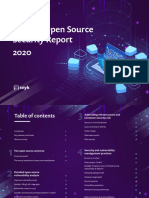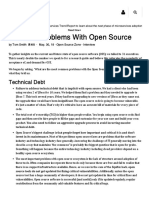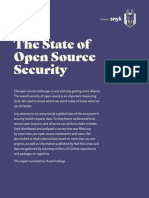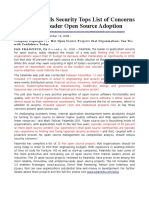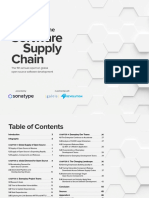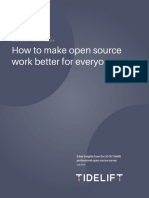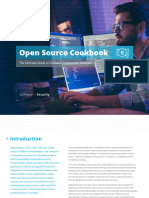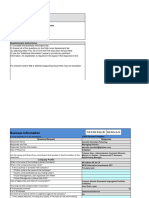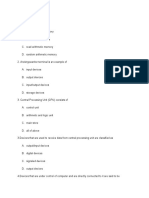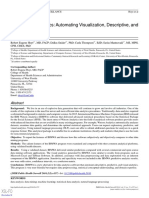Open Logic Survey 2020 State Open Source Report
Uploaded by
plopOpen Logic Survey 2020 State Open Source Report
Uploaded by
plop2020 State of
Open Source Report
Market Trends, Analysis, & Looking Ahead
OpenLogic by Perforce © Perforce Software, Inc. All trademarks and registered
www.openlogic.com trademarks are the property of their respective owners. (0920AD20)
2020 STATE OF OPEN SOURCE REPORT
Executive Summary
The 2020 State of Open Source Report from OpenLogic provides data on the most popular open
source technologies used today, and sheds light on the barriers and benefits teams experience
when adopting open source technologies.
Foreword
To the reader,
I’ve been predicting the future for a long time. Even before I founded OpenLogic back in 1998, I
thought companies would eventually use open source in critical applications if they could mitigate
the associated technical and business risks.
I also anticipated an explosion in the number of open source software (OSS) projects, even though
a well-known venture capitalist told me there would eventually be only 10 major OSS packages in
the world. Oops.
I wasn’t thinking this big at the time, but fast forward 22 years to a world where GitHub has well
over 100 million repositories and then consider we’re not done growing yet — not by a long shot.
Since OpenLogic created the industry’s first enterprise Open Source Census in 2008, we’ve seen
some common results from our community surveys. Support is the number one reason why teams
aren’t adopting OSS faster. Developers use way more OSS than management thinks they do,
especially if they think it’s ‘none.
Security grows in importance every year — this year it became the most important factor when
purchasing software — which is good! OSS quality is good, but many people struggle with
documentation, migrations, keeping up with patches, and the “tyranny of choice” between open
source options.
OpenLogic by Perforce © Perforce Software, Inc. All trademarks and registered
www.openlogic.com
trademarks are the property of their respective owners. (0920AD20)
For several years, we’ve also seen JavaScript top the most popular languages list and Python
continue to gain momentum, strongly driven by its domination in the AI space. However, all the
languages we asked about have significant usage. More than ever, developers are polyglots and
choose the best tool for the job. Based on the responses to our language mix question, they care
about flexibility and ease of deployment more than anything else when it comes to assembling the
right mix of technologies. This shows that user experience applies to developers as much as it does
to end users. After all, anything that makes our lives easier when writing code is most welcome!
One surprise I found in the results this year is that only half of the respondents use one of the
popular tools for automation and orchestration, such as Ansible, Puppet, Chef, or Terraform. If you
fit in the same category, please use automation to accelerate DevOps. You will get better quality
and reduce your stress while shipping faster.
I was also pleasantly surprised to see Istio, the open source service mesh, hit the radar for the first
time this year. If you have a complex microservices architecture not based on a service mesh, check
it out. Among many great benefits, you will avoid tons of duplicated effort and get a more resilient
production environment as a result.
Read on to learn more about what your peers are using, what they are avoiding, and where the
industry is heading. If there is one easy prediction I can make about the future, it is this: we will see
even more open source usage next year, particularly in innovative areas like AI and service mesh.
Enjoy the report,
Rod Cope
CTO, Perforce Software
OpenLogic by Perforce © Perforce Software, Inc. All trademarks and registered
www.openlogic.com
trademarks are the property of their respective owners. (0920AD20)
Table of Contents
5 About the Survey
6 Open Source Adoption Rates & Trends
8 Reservations for Adopting Open Source Software
9 Top Technologies in Infrastructure
10 Infrastructure Considerations
11 Infrastructure – High Availability
12 Top Technologies in Applications/Runtime
13 Applications/Runtime Considerations
15 Top Technologies in Databases/Analytics
16 Database/Analytics Considerations
17 SDLC + Build Technologies
18 SDLC + Build Technology Considerations
20 Automation + Orchestration Technologies
21 Automation + Orchestration Considerations
22 Top Support Requests
23 Today’s World and Looking Ahead
25 Additional Resources
OpenLogic by Perforce © Perforce Software, Inc. All trademarks and registered
www.openlogic.com
trademarks are the property of their respective owners. (0920AD20)
5 | 2020 State of Open Source Report
About the Survey
The 2020 State of Open Source Report from OpenLogic is based on an anonymous survey
conducted between April and July of 2020. The survey received a total of 1085 responses.
The survey focused primarily on open source industry adoption, organizations’ software
considerations, and the most widely used technologies within:
• Infrastructure and Operation Systems
• Applications and Runtime
• Databases and Analytics
• SDLC and CI/CD
• Automation and Orchestration
Reporting & Analysis Methodology
To make the report more scannable, we created graphs that disregard outliers. For this report,
we considered any question choice with fewer than 1% of respondent choice to be an outlier.
Respondents
For collecting this survey data, we reached out to IT operations and development professionals
with experience in several open source technologies to gain understanding in their software
requirements and support needs. This report gives insight into the types of technology
organizations are using and their main concerns when it comes to utilizing open source software.
OpenLogic by Perforce © Perforce Software, Inc. All trademarks and registered
www.openlogic.com
trademarks are the property of their respective owners. (0920AD20)
6 | 2020 State of Open Source Report
Survey Results
Open Source Adoption Rates & Trends
Is your organization using open source software?
90% of respondents in this survey stated that they are utilizing open source software within
their technology stack. Given the skyrocketing rate of open source adoption within commercial
organizations within the past few years, this is no surprise.
Is your organization considering any new open source
technologies?
79% of respondents replied that they are considering new technologies within open source.
Considering 90% of respondents are already using open source, this reinforces the success that
businesses are having with open source software. Organizations are seeing the initial benefits and
they are seeking more opportunities to use it.
Software Purchasing Considerations
In this question, we asked respondents to rank (from not important-most important) their
organization’s considerations when purchasing software. Considerations included: Licensing
Costs, Enterprise Support, Software Security, Functionality, and Internal Competency.
OpenLogic by Perforce © Perforce Software, Inc. All trademarks and registered
www.openlogic.com
trademarks are the property of their respective owners. (0920AD20)
7 | 2020 State of Open Source Report
LICENSING COSTS FUNCTIONALITY
4% 1%
12% 2%
34% 13%
33% 43%
18% 42%
ENTERPRISE SUPPORT INTERNAL COMPETENCY
6% 4%
16% 11%
30% 34%
32% 35%
16% 16%
SOFTWARE SECURITY
1% Not important
4% Mildly important
16% Important
35% Very important
44% Most important
Over 44% of respondents listed software security as the most important consideration in
purchasing software, with functionality trailing slightly at 42%.
Is this consideration for security an artifact of the long-held mythology that open source is less
secure? Or does it represent the importance of software security among development teams?
Regardless, keeping data secure is a top reported priority.
Other concerns, like licensing cost, internal competency, and enterprise support were rated less
important than security and functionality, on average.
OpenLogic by Perforce © Perforce Software, Inc. All trademarks and registered
www.openlogic.com
trademarks are the property of their respective owners. (0920AD20)
8 | 2020 State of Open Source Report
Reservations for Adopting Open Source Software
Many of our respondents, as noted in previous sections, are already utilizing open source software
or are currently considering new software. But that does not mean adoption is coming without
certain reservations.
What are you reservations in migrating to open source software?
29% Unsecured or untested
38% Can’t get support for it
23% Doesn’t scale as well as commercial software
15% Just for proof of concept
21% Can’t convince business leadership
37% No reservations
5% Other
Our survey found that 38% of respondents reported support as a pain point for open source
software adoption. An additional 29% reported security and testing concerns as their primary
obstacle, while 23% reported concerns with scalability as compared to commercial software
options as their primary.
For those who have been in the industry for the last few decades, support has long been the
biggest hurdle for adoption. Luckily for developers, OpenLogic provides full enterprise support for
over 400 open source technologies, including 24/7 break/fix support and consultative guidance.
Seeing that over a third of respondents report no reservations about adopting open source
software shows the impressive trajectory of open source software quality, reliability, and adoption.
The concerns over security and testing are interesting to see, especially considering that the code
within typical open source software is always validated and never goes untested. Anecdotally,
security and testing accountability for code within open source software is often higher than code
within commercial counterparts.
OpenLogic by Perforce © Perforce Software, Inc. All trademarks and registered
www.openlogic.com
trademarks are the property of their respective owners. (0920AD20)
9 | 2020 State of Open Source Report
Top Technologies in Infrastructure
In this question, we asked respondents to list the infrastructure technologies they use to support
their software. So what do those results look like in the “year of the container?”
38% CentOS
25% RHEL
56% Ubuntu
22% Debian
4% SLES
9% Open SUSE
56% Docker
38% Kubernetes
4% Istio
12% Other
Our survey found that 56% of respondents reported using Docker, with 56% using Ubuntu. Trailing
behind the top two technologies, we saw Kubernetes and CentOS at 38% a piece. Moving down
the list, RHEL usage showed at just over a quarter of respondents, with Debian, OpenSUSE,
and SLES coming in at 22%, 9%, and 4%, respectively. Finally, the open source service mesh
technology, Istio, came in at 4%.
There are a few interesting points here, namely Ubuntu outpacing CentOS, and CentOS outpacing
RHEL. With many users migrating from RHEL to CentOS to gain infrastructural freedom, that trend is
likely to continue.
It’s also important to note the emergence of Istio as an open source service mesh option. While
Istio adoption isn’t on pace with Kubernetes, there is plenty of room for it to grow market share in
coming years.
OpenLogic by Perforce © Perforce Software, Inc. All trademarks and registered
www.openlogic.com
trademarks are the property of their respective owners. (0920AD20)
10 | 2020 State of Open Source Report
Infrastructure Considerations
For this question, we asked respondents to tell us what they considered most important when
choosing which technology mix to use for their infrastructure. In order of importance (not important
– most important) respondents ranked the following reasons: Security and Patches, Commercial
Support, Freedom and Flexibility, License Costs, and Internal Competency.
SECURITY AND PATCHES LICENSE COST
2% 4%
4% 12%
23% 28%
37% 22%
34% 24%
COMMERCIAL SUPPORT INTERNAL COMPETENCY
11% 5%
18% 10%
28% 38%
29% 31%
14% 17%
FREEDOM AND FLEXIBILITY
2% Not important
6% Mildly important
24% Important
42% Very important
25% Most important
OpenLogic by Perforce © Perforce Software, Inc. All trademarks and registered
www.openlogic.com
trademarks are the property of their respective owners. (0920AD20)
11 | 2020 State of Open Source Report
Our survey found that security and patches were the most important point of consideration
when choosing infrastructure technologies, with 34% of respondents reporting it as their most
important consideration.
Behind security and patches, freedom and flexibility was the next most popular choice. The
weighted average for responses found that freedom and flexibility trailed security and patches
only slightly, showing that many respondents found it as the biggest payoff in choosing new
infrastructure technologies.
License cost, internal competency, and commercial support trailed these choices, showing
security concerns as a continuing theme among teams considering open source technologies.
Infrastructure – High Availability
Next, we asked respondents to weigh in on their team’s ability to keep infrastructure technology
highly available in production.
I feel confident in my team’s ability to keep our
infrastructure technology highly available in production.
89% True
11% False
Our survey found nearly 90% of respondents reporting confidence in maintaining high availability
in production.
This is a massive change from just a couple years ago, where high availability was a big concern.
So what changed? In the last few years there has been a significant increase in cloud technology
adoption, as well as advancements in failover tech, and general software maturity. With
organizations able to offload a lot of their redundancy and failover to cloud services, and software
just getting better in general, availability is becoming a solved problem.
OpenLogic by Perforce © Perforce Software, Inc. All trademarks and registered
www.openlogic.com
trademarks are the property of their respective owners. (0920AD20)
12 | 2020 State of Open Source Report
Top Technologies in Applications/Runtime
In this question, we asked respondents to select the technologies they use to build applications.
Which technologies do you use to build your applications today?
38% OpenJDK
35% Oracle Java
35% PHP
42% Node.js
12% Golang
36% C / C++
29% C#
53% Python
54% Javascript (other than Node.js)
11% Other
Our survey found 54% of respondents using Javascript, 53% using Python, 42% using Node.js, and
over 38% using OpenJDK.
Trailing those, C / C++ users reported in at 35%, and Oracle Java and PHP users at 36%
respectively. Lastly, over 28% of respondents reported using C#, with another 12% using Golang.
While it was interesting to see OpenJDK outpacing Oracle Java (as predicted by Gartner), the big
surprise is with Python – which fell just short of JavaScript for the most popular language. New open
advancements in AI and scientific / analytics software is likely driving a lot of this adoption, with
Python being incredibly popular in those fields in particular.
Nearly every language on this list is in heavy rotation – showing that technologies are more able to
support the increasingly polyglottal nature of development.
OpenLogic by Perforce © Perforce Software, Inc. All trademarks and registered
www.openlogic.com
trademarks are the property of their respective owners. (0920AD20)
13 | 2020 State of Open Source Report
Applications/Runtime Considerations
For this question, we asked respondents to tell us in order of importance (not important – most
important) the reasons they chose their development technology mix. Reasons provided were:
Internal Competency, Commercial Support, Freedom and Flexibility, Ease of Deployment, Features
and Functionality.
INTERNAL COMPETENCY EASE OF DEPLOYMENT
4% 1%
7% 5%
30% 23%
28% 42%
21% 29%
COMMERCIAL SUPPORT FEATURES AND FUNCTIONALITY
14% 1%
18% 2%
26% 16%
29% 39%
13% 42%
FREEDOM AND FLEXIBILITY
2% Not important
5% Mildly important
24% Important
41% Very important
28% Most important
OpenLogic by Perforce © Perforce Software, Inc. All trademarks and registered
www.openlogic.com
trademarks are the property of their respective owners. (0920AD20)
14 | 2020 State of Open Source Report
Our survey found that the most important consideration for respondents when choosing
development technologies was in features and functionality. Next, ease of deployment and
freedom and flexibility were nearly split, with 29% and 28%, respectively. Internal competency
and commercial support were the least important considerations, with 21% of respondents
reporting internal competency, and 13% reporting commercial support as their most important
consideration.
These findings are in line with other responses within the survey, and show a trend that teams
put a high value on the functionality, flexibility, and ease of use for development technologies.
OpenLogic by Perforce © Perforce Software, Inc. All trademarks and registered
www.openlogic.com
trademarks are the property of their respective owners. (0920AD20)
15 | 2020 State of Open Source Report
Top Technologies in Databases/Analytics
Our next question asked respondents to weigh in with the database and analytics technologies
they use today.
Which databases and/or analytics technologies are you using today?
24% MariaDB 2% CockroachDB
64% MySQL 14% Apache Spark
33% OracleDB 13% Hadloop ecosystem
10% DB2 23% ElasticSearch
35% Postgres 23% Redis
11% Cassandra 9% TensorFlow
37% MongoDB 13% Other
5% CouchDB
MySQL was by far the most popular choice, with nearly two thirds of respondents reporting using
a MySQL database in their current application. Behind MySQL, MongoDB, Oracle DB and MariaDB
were the next most popular, at 37%, 33%, and 24% adoption, respectively.
It was interesting to see Postgres outpacing Oracle within this audience, as other surveys have
shown Oracle DB well ahead of Postgres. The high level of MySQL adoption shows that despite
being an older database technology, it has a lot of staying power.
OpenLogic by Perforce © Perforce Software, Inc. All trademarks and registered
www.openlogic.com
trademarks are the property of their respective owners. (0920AD20)
16 | 2020 State of Open Source Report
Database/Analytics Considerations
In this question, we asked respondents to tell us in order of importance (not important – most
important) the reasons they chose their database/analytics technology mix. Reasons provided
were: HA / DR Capabilities, Big Data Needs, Scaling for Clients, Ease of Use/Deployment, Features
and Functionality.
LICENSING COSTS FUNCTIONALITY
4% 1%
12% 2%
34% 13%
33% 43%
18% 42%
ENTERPRISE SUPPORT INTERNAL COMPETENCY
6% 4%
16% 11%
30% 34%
32% 35%
16% 16%
SOFTWARE SECURITY
1% Not important
4% Mildly important
16% Important
35% Very important
44% Most important
OpenLogic by Perforce © Perforce Software, Inc. All trademarks and registered
www.openlogic.com
trademarks are the property of their respective owners. (0920AD20)
17 | 2020 State of Open Source Report
Our survey found that features and functionality were the most important considerations for
choosing database and analytics technologies. Ease of use and deployment considerations
were also important, followed by scaling, HA / DR capabilities and big data needs.
It is interesting that ease of use was rated so highly for databases and analytics tools. Many
analysts don’t necessarily have a strong software background, so having easy to use software
often leads to better adoption.
SDLC + Build Technologies
This question asked respondents to select the SDLC and build technologies they currently use.
Which SDLC and build technologies are you using today?
52% Jenkins 18% Artifactory
35% Maven 7% Mocha
21% Gradle 24% Junit
14% Ant 17% gcc
73% Git/GitLab 8% None of the above
21% SonarQube 8% Other
10% Sonartype Nexus
Our survey found the most popular technologies are Git / GitLab at 73%, Jenkins at 52%, and
Maven at 35%.
It’s no surprise to see Git and Jenkins at the top of the charts here, though it is surprising to see
Maven still edging out Gradle as the most popular Java build tool.
OpenLogic by Perforce © Perforce Software, Inc. All trademarks and registered
www.openlogic.com
trademarks are the property of their respective owners. (0920AD20)
18 | 2020 State of Open Source Report
SDLC + Build Technology Considerations
For this question, we asked respondents to tell us in order of importance (not important – most
important) the reasons they chose their SDLC and build technology mix. Reasons provided were:
HA / DR Capabilities, Internal Competency, Scaling for Clients, Ease of Use/Deployment, Features
and Functionality.
HA/DR CAPABILITIES EASE OF USE, DEPLOYMENT
13% 3%
15% 3%
31% 24%
27% 39%
14% 31%
INTERNAL COMPENTENCY FEATURES AND FUNCTIONALITY
4% 2%
9% 4%
35% 22%
33% 36%
19% 36%
SCALING FOR MANY CLIENTS
8% Not important
12% Mildly important
27% Important
31% Very important
22% Most important
OpenLogic by Perforce © Perforce Software, Inc. All trademarks and registered
www.openlogic.com
trademarks are the property of their respective owners. (0920AD20)
19 | 2020 State of Open Source Report
Our survey found that features and functionality and ease of use were the most important factors in
choosing SDLC and build technologies. 36% of respondents reported features and functionality as
the most important factor, while 31% reported ease of use and deployment considerations as the
most important factor.
The wider a feature set of an SDLC stack, the more able it is to deploy to a wide set of environments.
That means more cloud compatibility, easier integration with newer deployment infrastructure like
Kubernetes, and in general more value for the organization who is adopting the stack.
Internal competency, scaling, and HA / DR capabilities were viewed, on average, as less
important factors.
OpenLogic by Perforce © Perforce Software, Inc. All trademarks and registered
www.openlogic.com
trademarks are the property of their respective owners. (0920AD20)
20 | 2020 State of Open Source Report
Automation + Orchestration Technologies
In this question, we asked respondents to select the automation and orchestration technologies
they use today.
24% Ansible
16% Puppet
7% Salt
13% Chef
17% Terraform
7% Rancher
5% Kubespray
11% Helm
50% None of the above
4% Other
Our survey found Ansible to be the most popular technology, with nearly a quarter of respondents
using the open source software.
Terraform, Puppet, Chef, and Helm were the only other technologies above 10%, at 17%, 16%, 13%,
and 11%, respectively.
50 of respondents reported not using any of the listed, industry-standard tools. What does that
mean? It could be that many teams are either doing this work manually, rolling their own tools, or
have a big opportunity to improve automation.
With Ansible continuing to grow as a proven, stable, open source orchestration solution, we expect
to see more teams adopting it, and realizing the benefits of IT automation and orchestration in
coming years.
OpenLogic by Perforce © Perforce Software, Inc. All trademarks and registered
www.openlogic.com
trademarks are the property of their respective owners. (0920AD20)
21 | 2020 State of Open Source Report
Automation + Orchestration Considerations
Our next question asked respondents to select their considerations for automation and
orchestration technology adoption.
SCALING FOR MANY CLIENTS/TRANSACTION EASE OF USE, DECLARATIVE SYNTAX
18% 13%
8% 7%
30% 29%
26% 32%
18% 19%
CENTRAL MANAGEMENT AND MONITORING FEATURES AND MODULES
13% 13%
7% 6%
26% 26%
33% 31%
21% 24%
SECURITY ACCESS AND CONTROL
13% Not important
6% Mildly important
22% Important
29% Very important
30% Most important
OpenLogic by Perforce © Perforce Software, Inc. All trademarks and registered
www.openlogic.com
trademarks are the property of their respective owners. (0920AD20)
22 | 2020 State of Open Source Report
Our survey found that the most important factor for choosing automation and orchestration
technologies was in security and access control, followed by features, management, and ease
of use. Scaling was reported as the least important factor.
The results point to an acknowledgement of the devastating consequences of a compromised
automation system and show the seriousness with which teams are now treating security in
these systems.
Top Support Requests
This next section shows a breakdown of our in-house customer support requests over the last 12
months, by technology.
12% ActiveMQ 4% Eclipse Platform Project
10% CentOS 4% Jenkins CI
9% Apache Tomcat 4% Apache Kafka
5% JBoss Application Server 2% Cassandra
5% Apache HTTP Server (httpd) 2% OpenLDAP
5% PosgreSQL 2% Keycloak
4% Java Developmen Kit (JDK) 2% Wildfly
It’s not surprising to see ActiveMQ, the open source Java-based messaging server, at the top of
the list. While powerful, and exceedingly useful, it’s also notoriously under-documented — which
makes paid, expert support essential.
The percentage of CentOS support requests is largely tied to customer percentage, as many
OpenLogic customers count on us to deliver cost-saving support and security for applications using
CentOS and RHEL.
OpenLogic by Perforce © Perforce Software, Inc. All trademarks and registered
www.openlogic.com
trademarks are the property of their respective owners. (0920AD20)
23 | 2020 State of Open Source Report
Today’s World and
Looking Ahead
There’s no other way to say it, the state of the world has accelerated our reliance on the software
technology that drives human interaction. The need for digital transformation, cloud native
infrastructure, and secure, functional code has never been more pronounced. Our gadgets, once
novel ways to interact outside of normal social settings, have, seemingly overnight, become our
primary means of work, education, and even socialization.
It’s not surprising to see free and/or open software continue to persist and bloom during
this transformative time. After all, remote collaborative culture has been the engine of open
development since the very beginning. Developers have been using technology to share code and
work together on projects for decades.
We’re now seeing in our developer communities a renewed sense of responsibility to the users for
whom they develop. Industry interest has begun to focus on verifiability of code, and businesses
have begun to think more about security and governance. The conversation is expanding in the
mainstream from exploitability to software ethics. How will we, for instance, ensure that the AI we
develop over the coming years exists solely to benefit humanity?
Ask the members of OpenAI, whose mission it is to ensure, through open source development and
transparent innovation, that it does just that.
With this rise in overall cultural maturity, so have businesses begun to shift their culture. This is
perhaps most evident in the early 2020 decision to install Jim Whitehurst of Red Hat as the new
President of IBM. As Forbes magazine put it, “Why? He Gets Culture.” It’s not only the survey
results in this important report that demonstrate the truth. You can see it in lobal business behaviors
as well. That truth? The market is all-in on free software and has no intention of looking back.
OpenLogic by Perforce © Perforce Software, Inc. All trademarks and registered
www.openlogic.com
trademarks are the property of their respective owners. (0920AD20)
24 | 2020 State of Open Source Report
So, what’s next, now that a majority of businesses have adopted an open-first policy? Our survey
results would suggest that enterprises are capitalizing on the merger of free software with cloud
native infrastructure, and enterprise cloud-native ISVs are circling their respective wagons. When
we can pull our software freely from public repositories and deploy our solutions on cloud assets
almost as instantly, our barriers to innovation become narrower and narrower. Freely available
dependencies work with open CI/CD technology to perform instant and resilient releases all the
time, rather than all at one time.
IBM’s purchase of Red Hat, and thereby OpenShift, represented the first major play outside of
Google for domination of the container-based cloud native infrastructure market segment. Open
source companies have risen and fallen in short spans of time, clamoring to be part of the “one
cloud-native container orchestration solution to rule them all.” With SUSE’s recent purchase of
Rancher, we’re in for quite a year as titans and newcomers alike compete on the equal playing field
of open innovation.
I hope that the insights you gain from this valuable report will help guide your thinking as the
landscape continues to shift under our feet. In the astronomically large and ever-blooming galaxy
that open source has become, the more tools we have to navigate, the more effective we will
remain in our work, education, and craft.
Justin Reock
Chief Architect, Perforce Software
OpenLogic by Perforce © Perforce Software, Inc. All trademarks and registered
www.openlogic.com
trademarks are the property of their respective owners. (0920AD20)
25 | 2020 State of Open Source Report
Questions?
Have questions about how OpenLogic can support your open source technologies? Get answers
from our team of open source experts today.
TALK TO AN OPEN SOURCE EXPERT
Ready to Build Your Open Source Stack?
Try the OpenLogic Stack Builder. It provides expert advice as you select your open source options.
Plus get a free, personalized report based on your choices.
BUILD TECHNOLOGY STACK
Additional Resources
Java Resources
• Forrester Report: Weighing the Options for Java Support
• Latest OpenJDK Guide
• Looking for a free OpenJDK Build? Check out our downloads page here.
Operating System Resources
• Whitepaper: Enterprise Linux at a Fair Price
• Video: Still on RHEL 6? Know Your Options
• Datasheet: CentOS 6 Enterprise Support
Other Trends in OSS
• A Guide to Open Source for Enterprise
• The Advantages of Ansible Orchestration
• Future of Open Source Software Development
OpenLogic by Perforce © Perforce Software, Inc. All trademarks and registered
www.openlogic.com
trademarks are the property of their respective owners. (0920AD20)
You might also like
- Application in The Security Age 1733606795No ratings yetApplication in The Security Age 173360679514 pages
- State of The Software Supply Chain - 2024-FINAL-10-10-24No ratings yetState of The Software Supply Chain - 2024-FINAL-10-10-2469 pages
- Forrester Report - Adopt Open Source Software To Improve Development EffectivenessNo ratings yetForrester Report - Adopt Open Source Software To Improve Development Effectiveness25 pages
- Instaclustr Forrester FOSS Vs Open CoreNo ratings yetInstaclustr Forrester FOSS Vs Open Core12 pages
- The State of Software Supply Chains - Canonical-IDC-GoogleNo ratings yetThe State of Software Supply Chains - Canonical-IDC-Google23 pages
- Palamida Finds Security Tops List of Concerns Inhibiting Broader Open Source AdoptionNo ratings yetPalamida Finds Security Tops List of Concerns Inhibiting Broader Open Source Adoption2 pages
- An85cZXTS 77H4Wcp6WZJq CTQXW9mmowzATahH96QbimfJtTSYe4kddg XGUmQNo ratings yetAn85cZXTS 77H4Wcp6WZJq CTQXW9mmowzATahH96QbimfJtTSYe4kddg XGUmQ14 pages
- REPORT Open-source-technology-in-the-age-of-AINo ratings yetREPORT Open-source-technology-in-the-age-of-AI21 pages
- Software Supply Chain 2019 Report-June 22 PDFNo ratings yetSoftware Supply Chain 2019 Report-June 22 PDF57 pages
- How To Make Open Source Work Better For EveryoneNo ratings yetHow To Make Open Source Work Better For Everyone26 pages
- Business Models and Strategies For Open Source Projects 1st Edition Francisco José Monaco Instant DownloadNo ratings yetBusiness Models and Strategies For Open Source Projects 1st Edition Francisco José Monaco Instant Download52 pages
- The State of Application Security, 2021No ratings yetThe State of Application Security, 202115 pages
- @enmagazine 2022-07-01 - Open - Source - For - YouNo ratings yet@enmagazine 2022-07-01 - Open - Source - For - You100 pages
- As More Open Source Companies Get Acquired, Questions and Tensions Are Raised About The Use of That SoftwareNo ratings yetAs More Open Source Companies Get Acquired, Questions and Tensions Are Raised About The Use of That Software5 pages
- As More Open Source Companies Get Acquired, Questions and Tensions Are Raised About The Use of That Software100% (1)As More Open Source Companies Get Acquired, Questions and Tensions Are Raised About The Use of That Software5 pages
- HashiCorp's Licensing Change Is Only The Latest Challenge To Open Source - The New StackNo ratings yetHashiCorp's Licensing Change Is Only The Latest Challenge To Open Source - The New Stack7 pages
- Business Models and Strategies For Open Source Projects 1st Edition Francisco José Monaco DownloadNo ratings yetBusiness Models and Strategies For Open Source Projects 1st Edition Francisco José Monaco Download128 pages
- Myths About Running Open Source Software in Your Business: White PaperNo ratings yetMyths About Running Open Source Software in Your Business: White Paper8 pages
- The State of Kubernetes Open Source SecurityNo ratings yetThe State of Kubernetes Open Source Security27 pages
- 2019 Year End Vulnerability QuickView ReportNo ratings yet2019 Year End Vulnerability QuickView Report20 pages
- The Complete Guide On Open Source SecurityNo ratings yetThe Complete Guide On Open Source Security16 pages
- 451 Research Monitoring Time For ChangeNo ratings yet451 Research Monitoring Time For Change16 pages
- Driving Efficiency and Sustainability - The Business Value of OSS in AutomotiveNo ratings yetDriving Efficiency and Sustainability - The Business Value of OSS in Automotive26 pages
- 2024 Open Source Security and Risk Analysis Report WRAPPEDNo ratings yet2024 Open Source Security and Risk Analysis Report WRAPPED19 pages
- Proprietary and Open Source Software: Edward MwalimuNo ratings yetProprietary and Open Source Software: Edward Mwalimu35 pages
- TT8750AT002 - Garmin FMI AT Command SupplementNo ratings yetTT8750AT002 - Garmin FMI AT Command Supplement75 pages
- Disaster Recovery Interview Questions and Answers - HelloIntern - in - Blog100% (1)Disaster Recovery Interview Questions and Answers - HelloIntern - in - Blog12 pages
- USB Audio/MIDI Interface: Reference ManualNo ratings yetUSB Audio/MIDI Interface: Reference Manual24 pages
- IBM Watson Analytics Automating Visualization DescNo ratings yetIBM Watson Analytics Automating Visualization Desc12 pages
- Nanoscope Analysis v140r1 Download InstructionsNo ratings yetNanoscope Analysis v140r1 Download Instructions1 page
- Artificial Intelligence in Manufacturing PDFNo ratings yetArtificial Intelligence in Manufacturing PDF12 pages



